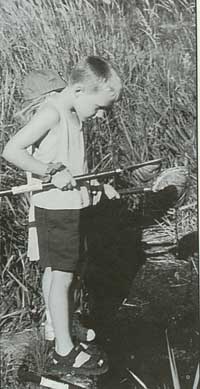 photo: Recreated natural landscapes need to be large enough to provide local residents with opportunities for interaction with native plants and wildlife admire the natural beauty of these areas, or they ignored them and paid them no further mind (a form of passive acceptance) The landscape of upper-class Europe didn't always transplant well to new soils and climates, but with time and considerable effort, we made it fit. Today, we must still often work very hard at getting the European landscape model to fit our climate, but it feels right enough to be worth the effort and expense. |
People do not willingly accept change, especially change they can see out their kitchen window. The modern landscape aesthetic is deeply ingrained in the minds of most American urban dwellers, who are raised amid close-cropped lawns, straight trees and orderly flower beds. It is something we inherited from our forebears, who dreamed of civilizing an untamed land and bringing prosperity to its new inhabitants. The outward expressions of these ideals came from Europe, the most civilized and prosperous place anyone knew of at that time. People can change their landscape aesthetic, as evidenced by the minority who actually love and appreciate prairies, wetlands and native woodlands enough to plant them around their homes. Those who live near wild places learn, over time, to appreciate their qualities: diversity, tangibility, endurance, and beauty that can be both stunning and subtle. Many an urbanite has experienced something akin to a revelation after spending time volunteering to help restore natural areas. Something about these rare wild places gets into their blood, and they begin to look at the typical suburban landscape as something flawed and out of place. It is neither our job nor our right to change the way people think and feel. However, it is our job and our responsibility to provide for the long-term recreational needs of our constituents and to serve as stewards of the lands we hold in the public trust. If returning some of our parks to nature's processes can help us to better manage those active recreational areas which requite intensive management, then we owe it to our constituents to employ these "best practices." However, rather than forcing the issue, and conducting large-scale re-creation of natural areas in your parks, introduce your neighbors to native plants and ecosystems in small doses. There are a variety of ways of planting these seeds of change in the minds and attitudes of your constituents. Following are a handful. |
· Replace high-maintenance annuals with low-maintenance native perennials in selected flower beds around park signs or near park entrances. Annuals or bulb plants could still be added to accent these plantings. · Plant a small or limited section of shoreline at one of your ponds or retention areas with wet prairie grasses and flowers or shrubs. · Design groupings of native trees and shrubs with a groundcover of mulch and low-growing wild grasses and spring wildflowers. Place these along the side of berms or in other rolling terrain to accent their features. · let residents know that you are designing a perennial wildflower bed in the park near their homes and invite them to help in the planting. · Encourage the use of native plants by your residents in their home landscape by bringing in a speaker to discuss the topic or by conducting a native wildflower and grass sale. It is important to be patient and understanding with your residents. Talk to them and address their concerns, but most importanly involve them! These small wild areas will grow on your residents, and eventually will be accepted, admired and imitated. You will have a constituency that is supportive of your landscape management practices.
In another part of Schaumburg, where homes were built around a large natural wetland, the residents love and appreciate the view from their kitchen windows. When staff replanted a prairie in a section of formerly mowed parkland adjacent to the marsh, local people asked if any more planting was planned. They wanted the area in back of their home to be next. |
Pages:|1 ||2 | |3 ||4 | |5 ||6 | |7 ||8 | |9 ||10 | Pages:|11 ||12 | |13 ||14 | |15 ||16 | |17 ||18 | |19 ||20 |
Pages:|21 ||22 | |23 ||24 | |25 ||26 | |27 ||28 | |28a ||28b| |28c ||28d| |29 ||30 |
Pages:|31 ||32 | |33 ||34 | |35 ||36 | |37 ||38 | |39 ||40 |
Pages:|41 ||42 | |43 ||44 | |45 ||46 | |47 ||48 | |49 ||50 | Pages:|51 ||52 | |53 ||54 | |55 ||56 |